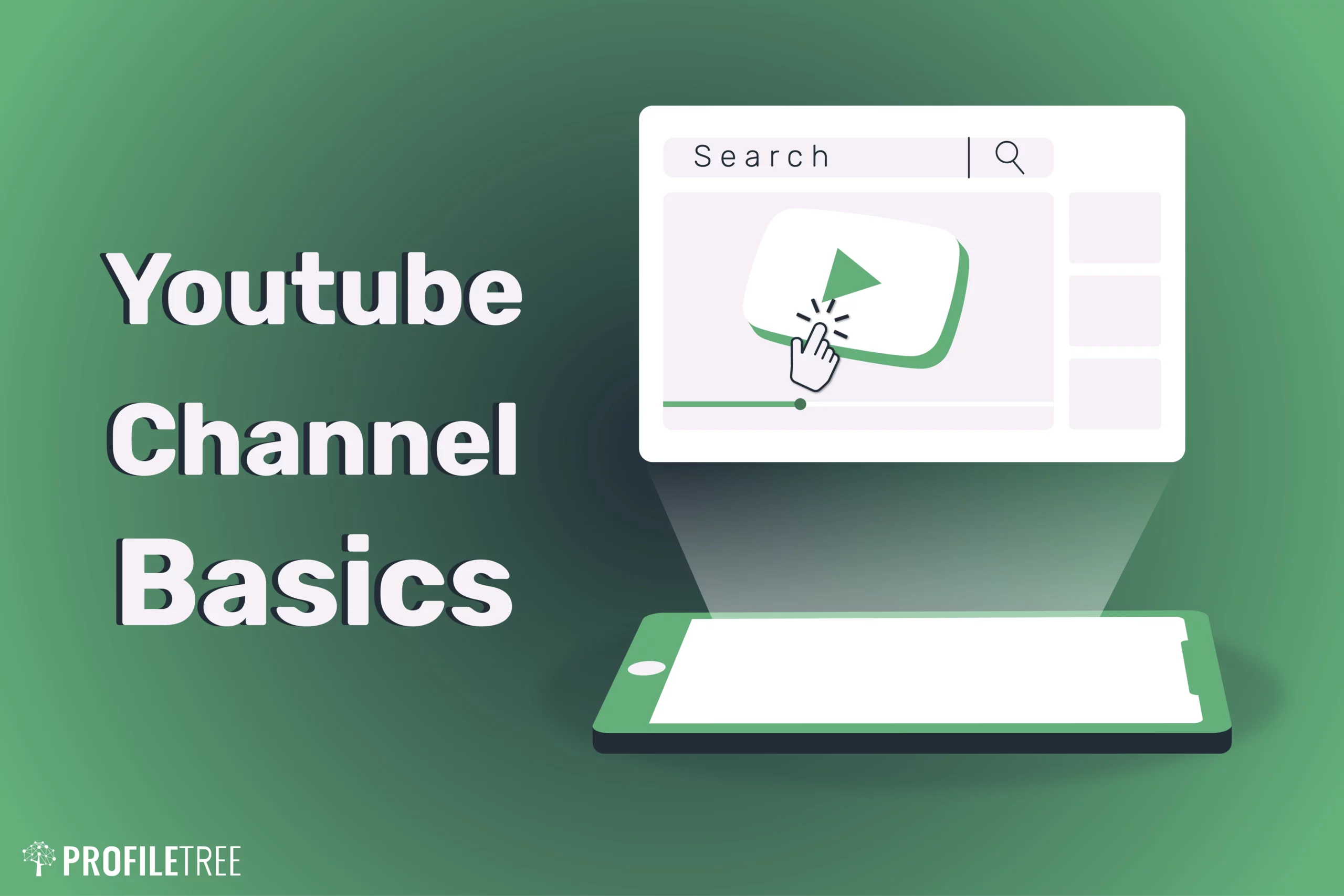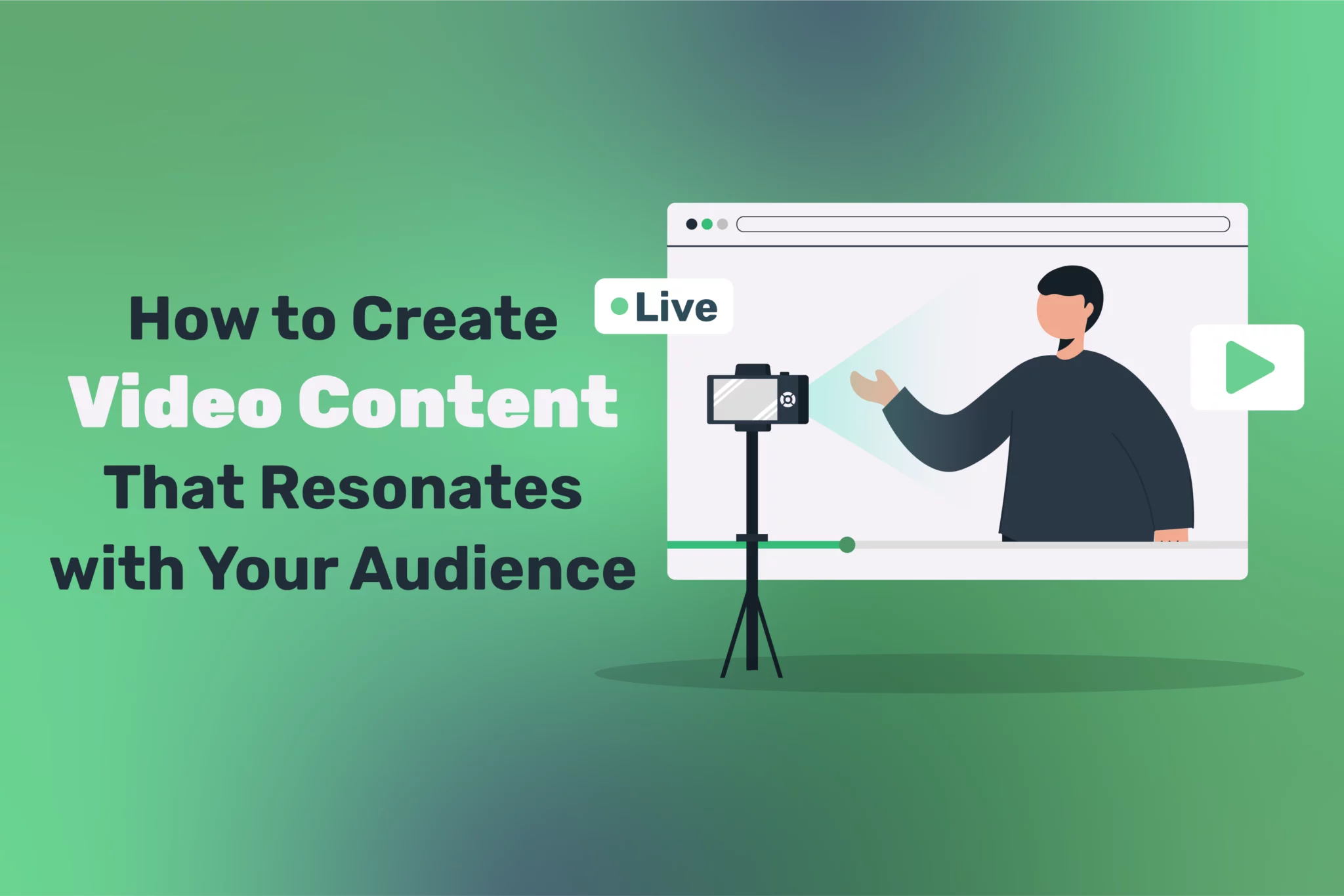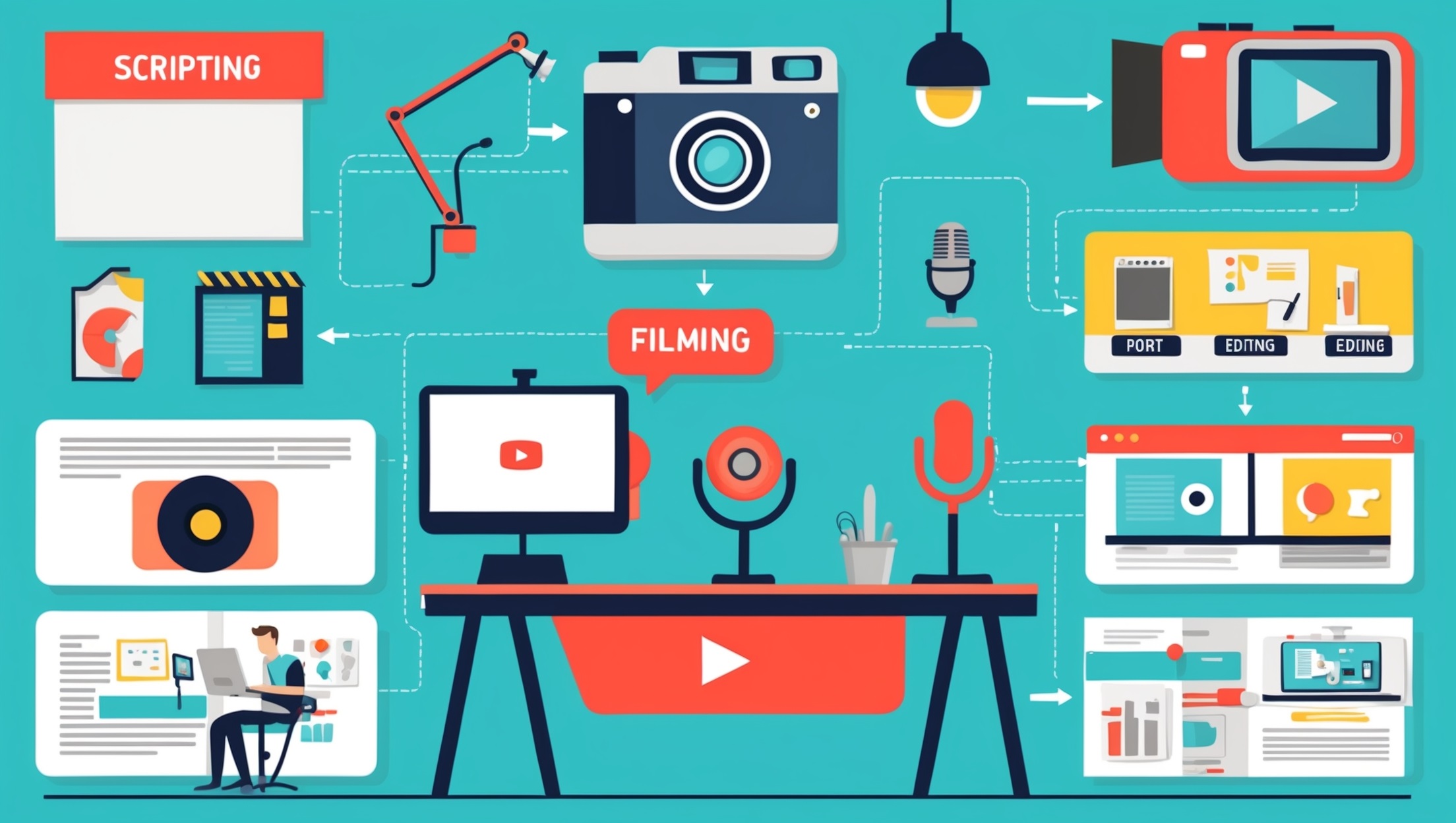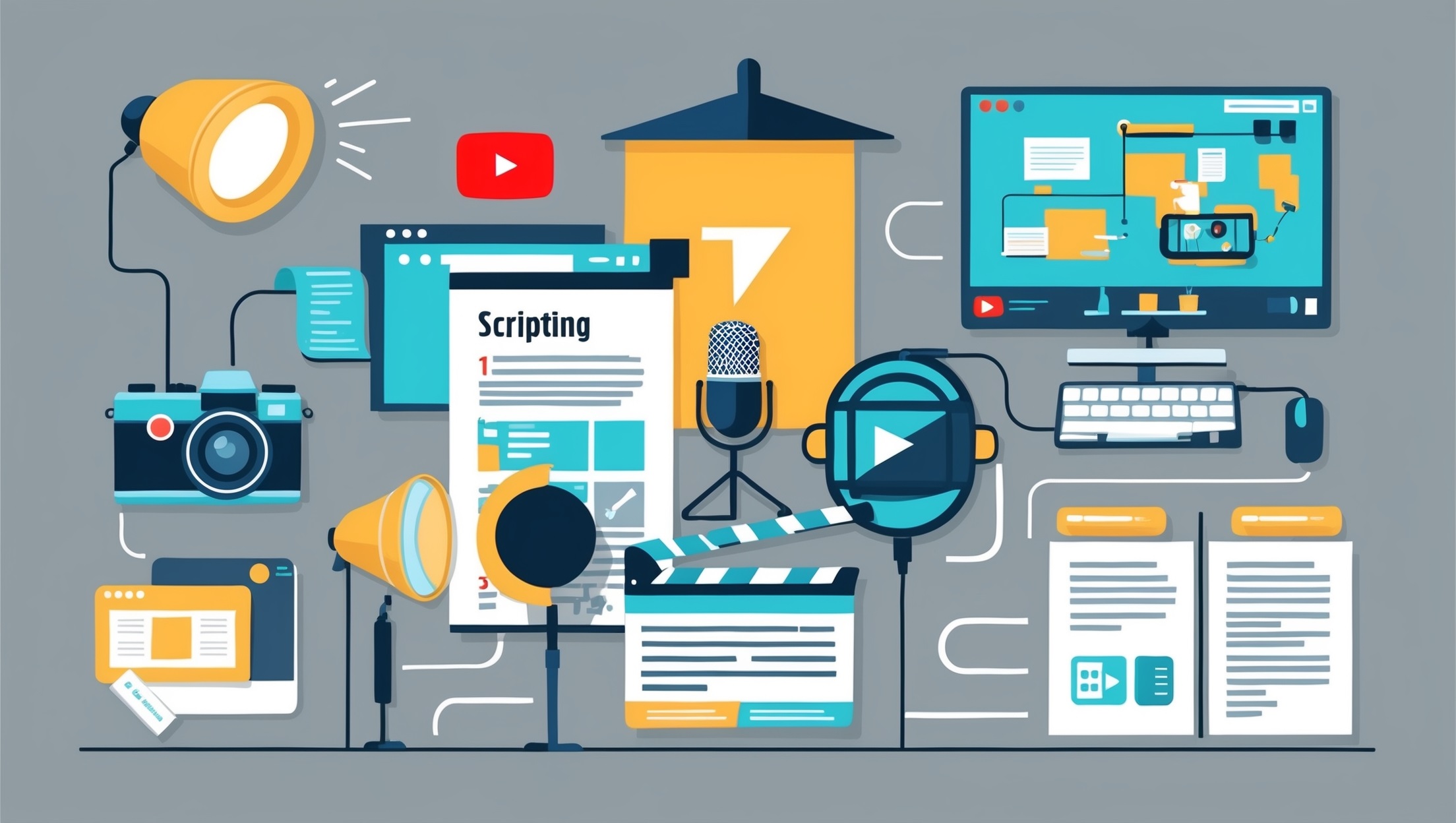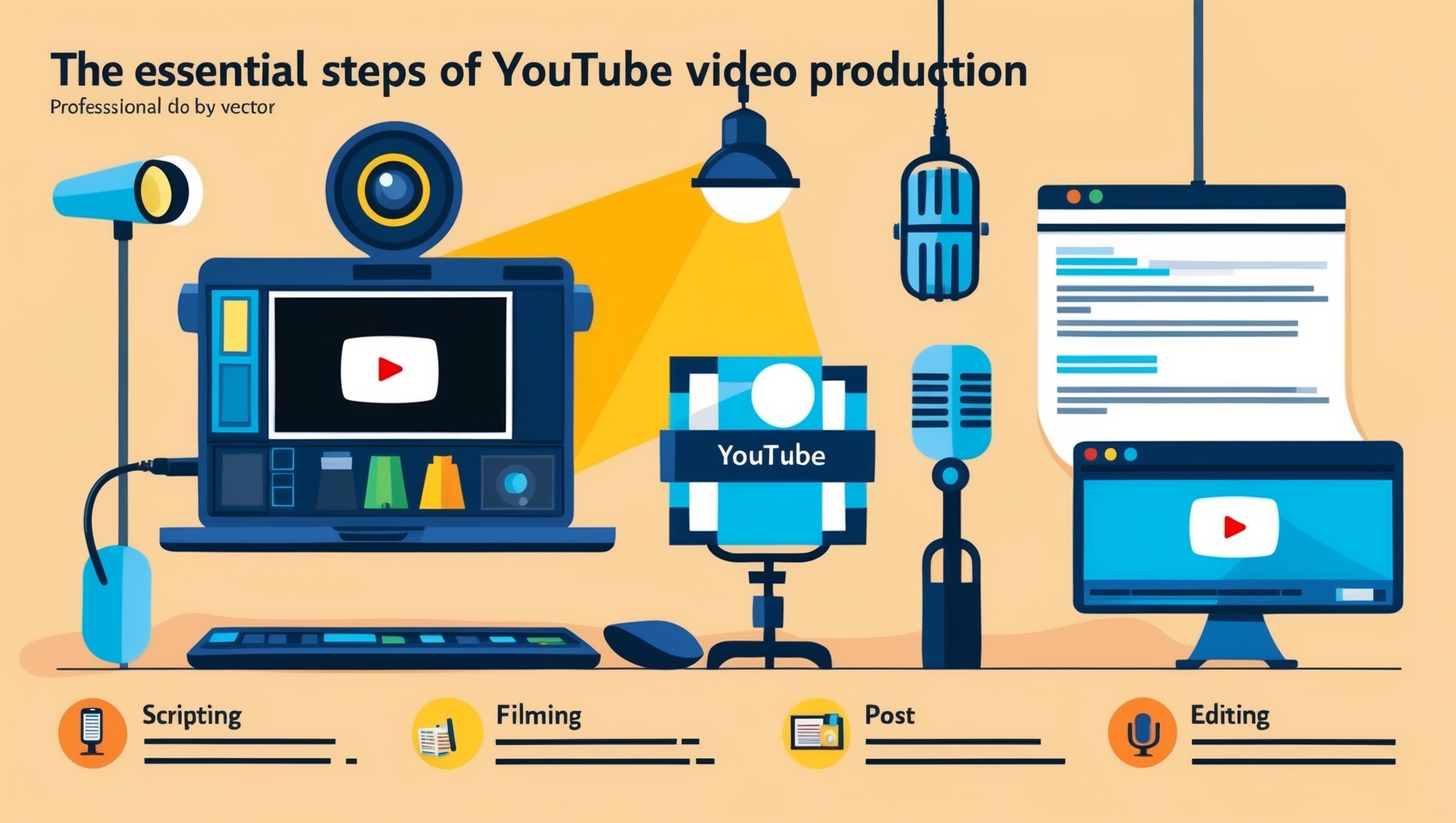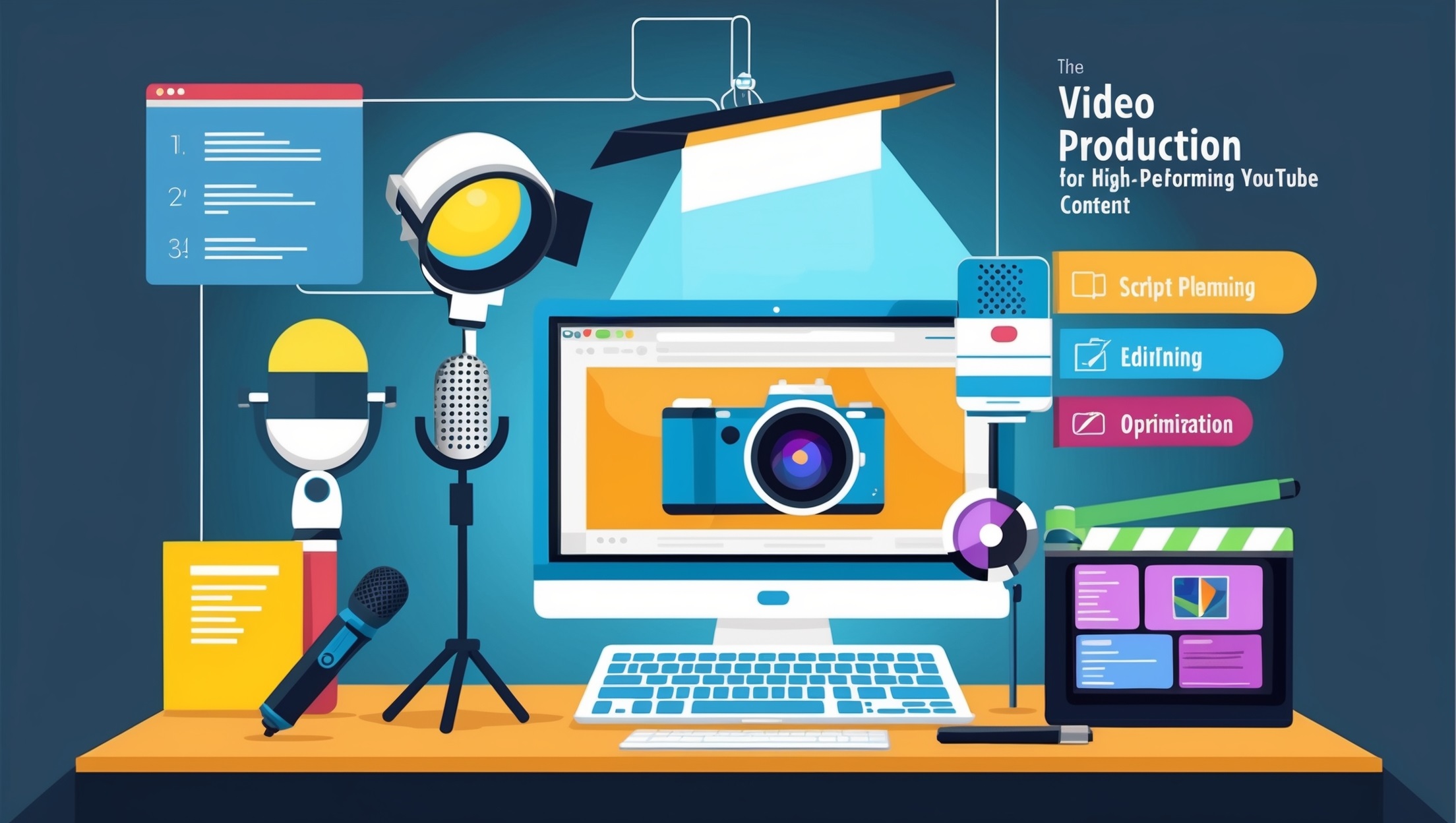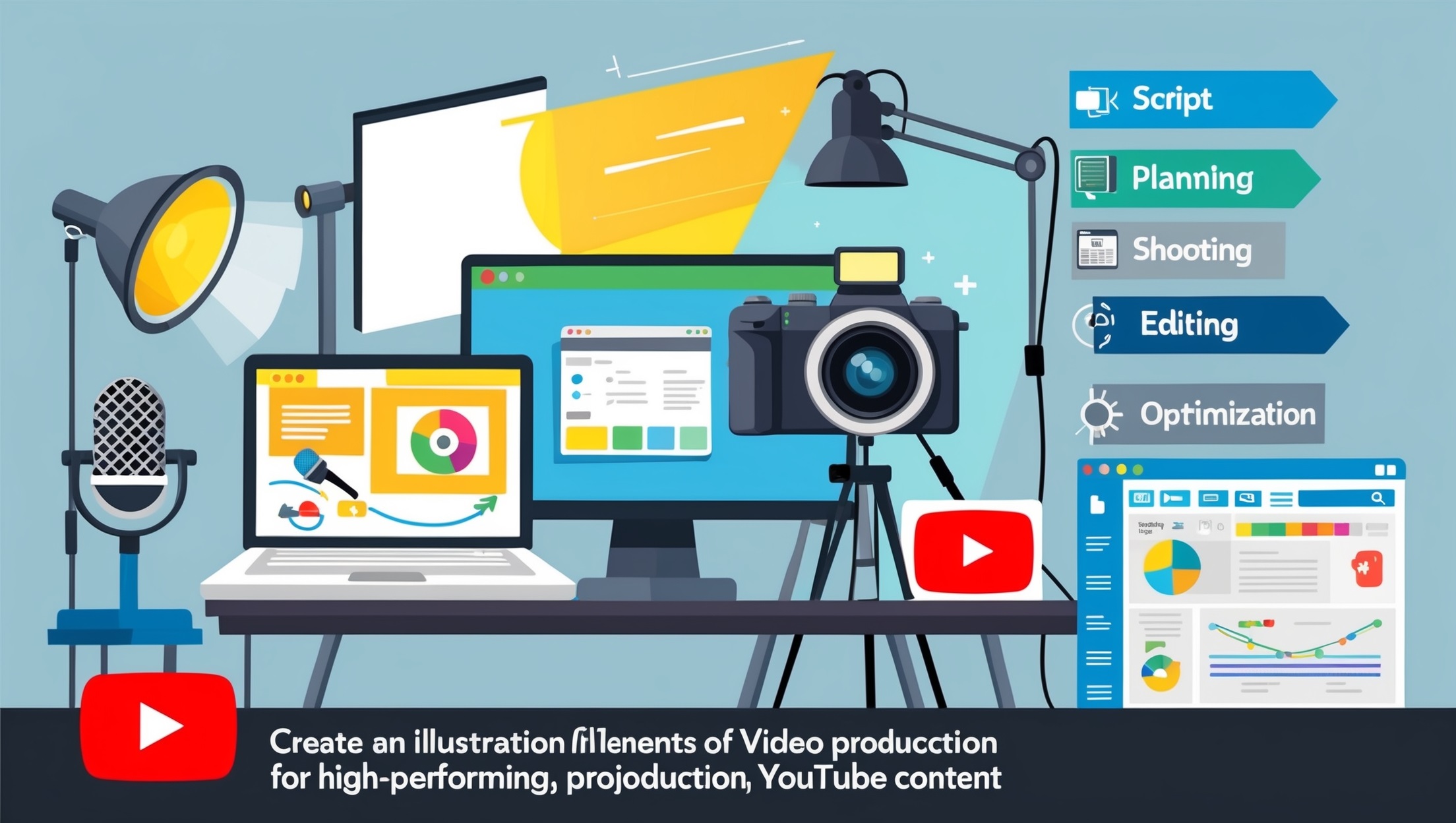Video Production Essentials for High-Performing YouTube Content
Whilst YouTube SEO and strategic promotion play significant roles in channel growth, the foundation of any successful channel ultimately rests on the quality of its video production. Each element—from meticulous pre-production planning and professional camera setups to sophisticated post-production editing and consistent brand presentation—shapes viewer perception and engagement. This comprehensive guide explores the video production essentials, equipment, and methodologies required to produce polished, compelling video content that distinguishes itself in YouTube’s increasingly competitive environment.
Strategic Pre-Production Effective pre-production sets the foundation for high-quality video content. Planning scripts, storyboards, locations, and equipment in advance ensures a smooth production process and maximises audience engagement .
Concept Development and Content Strategy Before touching any equipment, successful YouTube content begins with clear strategic intent:
Purpose and Value Proposition:
Audience-Centred Approach:
Research viewer demographics and preferences within your niche
Identify specific questions, challenges, or interests your audience has expressed
Analyse successful content in your category for inspiration
Consider search intent and how your content addresses viewer needs
Topic Refinement:
Narrow broad concepts into focused, actionable topics
Research current conversations and trending aspects of your subject
Develop a unique angle or perspective different from existing content
Consider seasonality and timeliness of your chosen topic
Structured Scripting and Content Planning Professional content requires thoughtful preparation:
Script Development Approaches:
Full Script: Complete dialogue and direction for highly structured contentDetailed Outline: Key points and talking points for more natural deliveryBullet Framework: Minimal structure for experienced presenters or conversational contentHybrid Approach: Scripted introductions and conclusions with outlined middle sections
Narrative Structure Elements:
Compelling Hook (0-15 seconds): Immediately communicate value or intrigueClear Introduction (15-60 seconds): Establish topic and what viewers will gainLogical Main Content: Organised into distinct, progressive sectionsEffective Conclusion: Summarise key points and provide closureStrategic Call-to-Action: Guide viewers toward next steps
Visual Storytelling Planning:
Map emotional journey and energy flow throughout the video
Plan visual demonstrations that complement verbal explanations
Identify opportunities for graphics, text overlays, or animations
Consider transitional elements between major content sections
Professional Storyboarding and Shot Planning Visualising content before filming saves time and improves quality:
Storyboard Development:
Create simple sketches representing key frames and visual sequences
Note camera angles, subject positioning, and compositional elements
Indicate movement, transitions, and special effects
Include text notes regarding dialogue or technical requirements
Shot List Creation:
Catalogue each required shot with specific details
Categorise by location, lighting setup, or equipment needs
Estimate time requirements for each setup
Prioritise shots based on importance and logistical considerations
Technical Planning:
Determine appropriate aspect ratios and framing for each sequence
Plan camera movements and transitions between shots
Identify special equipment needs for specific sequences
Consider backup options for technically challenging shots
Comprehensive Production Logistics Meticulous planning prevents costly delays and quality issues:
Location Scouting and Preparation:
Evaluate filming locations for lighting, acoustics, and visual appeal
Secure necessary permissions and access arrangements
Visit locations at planned filming times to assess lighting conditions
Identify potential challenges or required modifications
Equipment Preparation:
Create detailed equipment checklists for each filming session
Test all equipment for functionality before filming day
Prepare backup systems for critical components
Ensure sufficient media storage and battery capacity
Production Schedule Development:
Create realistic timeline allowing for setup and transitions
Schedule most important or complex shots when energy is highest
Build in buffer time for unexpected challenges
Consider subject availability and location access restrictions
Team Coordination:
Clearly define roles and responsibilities for all team members
Schedule pre-production meetings to review plans and address questions
Develop communication protocols for filming day
Create contingency plans for potential disruptions
Equipment Selection and Setup Choosing the right equipment—cameras, microphones, lighting, and stabilisers—directly impacts video quality. A well-planned setup ensures professional visuals and clear audio, enhancing viewer experience.
Camera Selection and Configuration Choosing the right camera technology significantly impacts production quality :
Camera Options by Production Level:
Entry Level: Modern smartphones with stabilisation and manual controlsIntermediate: Consumer mirrorless cameras or DSLRs (Canon EOS, Sony Alpha)Professional: Cinema cameras (Blackmagic Pocket, Sony FS series) or high-end mirrorlessSpeciality: Action cameras for dynamic shots or 360° cameras for immersive content
Essential Camera Features:
Resolution capability (minimum 1080p, preferably 4K)
Manual exposure and focus controls
Good low-light performance (high ISO with acceptable noise)
Recording time limitations and overheating considerations
External microphone inputs for superior audio
Camera Settings Optimisation:
Shoot in flat colour profiles for greater editing flexibility
Set appropriate frame rates (24fps for cinematic, 30fps for standard, 60fps+ for slow motion)
Configure white balance for consistent colour temperature
Select appropriate bit rates and codecs for desired quality
Use neutral picture profiles for maximum post-production control
Multi-Camera Considerations:
Match camera settings across multiple devices
Ensure synchronisation capabilities between cameras
Plan for consistent positioning and framing
Consider editing workflow for multi-camera footage
Professional Lighting Techniques Lighting fundamentally shapes the visual quality of your content :
Lighting Setups by Complexity:
Basic: Ring lights or single softbox for simple talking head videosStandard: Three-point lighting (key, fill, and backlight) for professional lookAdvanced: Multi-light setups with practical and accent lighting for cinematic qualityNatural: Window light with reflectors for authentic, organic feel
Lighting Equipment Options:
LED panels offering adjustable colour temperature and intensity
Softboxes for diffused, flattering light
Ring lights for even facial illumination and eye catchlights
Light stands with boom arms for precise positioning
Reflectors and diffusers for light modification
Strategic Lighting Approaches:
Create depth through lighting ratios between subject and background
Use backlighting to separate subjects from backgrounds
Consider colour theory when selecting gels or LED temperatures
Light backgrounds separately from subjects for greater control
Position lights to enhance facial features and reduce unflattering shadows
Location-Specific Considerations:
Assess and manage ambient light sources
Identify power source availability for lighting equipment
Plan for consistent lighting despite time-of-day changes
Develop portable lighting solutions for field production
Audio Excellence Strategies Superior audio quality often distinguishes professional from amateur content:
Microphone Selection by Application:
Lavalier (Lapel) Microphones: Discreet, close to mouth, ideal for dialogueShotgun Microphones: Directional pickup, versatile for various setupsCondenser Microphones: Studio quality for voiceovers and controlled environmentsDynamic Microphones: Excellent for loud environments or musical performancesWireless Systems: Freedom of movement for active presentations
Audio Recording Best Practices:
Position microphones as close to sound source as possible without visual intrusion
Monitor audio levels continuously during recording
Record room tone for each location to assist with editing
Use windscreens or pop filters to reduce unwanted noise
Capture separate audio tracks when possible for maximum editing flexibility
Common Audio Challenges and Solutions:
Echo reduction through acoustic treatment or location selection
Background noise minimisation through microphone selection and positioning
Wind noise management with appropriate windscreens
Clothing rustle prevention with proper lavalier mounting
Level consistency through monitoring and proper gain staging
Advanced Audio Techniques:
Dual-system recording for highest quality (separate audio recorder and camera)
Backup audio recording solutions for critical content
Spatial audio recording for immersive content
Mixing multiple microphones for complex scenes
Environmental sound design to enhance atmosphere
Camera Movement and Stabilisation Controlled movement adds production value and visual interest:
Stabilisation Equipment Options:
Tripods for stable, static shots with smooth pan and tilt
Monopods for mobility with improved stability
Gimbals for flowing, dynamic movement
Sliders for smooth linear movement
Steadicams for complex, operator-controlled motion
Movement Planning Considerations:
Determine purpose of movement (revealing information, following action, emotional effect)
Practice movements before recording critical content
Consider beginning and ending positions for each movement
Plan transition points between static and moving shots
Ensure movement speed complements content pacing
Static Shot Enhancement:
Use tripods with fluid heads for smooth adjustments
Lock down unnecessary axes of movement to prevent inadvertent motion
Consider remote control systems for precise adjustments
Implement proper weight distribution for maximum stability
Use level indicators to ensure properly aligned horizons
Advanced Movement Techniques:
Motivated camera movement responding to subject action
Reveal techniques to progressively disclose information
Push/pull movements to emphasise emotional content
Parallax effects creating visual depth
Tracking shots maintaining consistent framing of moving subjects
Framing, lighting, and smooth camera movements are key to engaging visuals . Focus on storytelling, composition, and high-quality audio to create compelling footage that resonates with your audience.
Composition and Framing Fundamentals Thoughtful visual arrangement significantly enhances viewer engagement:
Compositional Guidelines:
Rule of thirds for balanced, interesting framing
Leading lines to direct viewer attention
Headroom and looking room for natural-feeling shots
Symmetry or intentional asymmetry for visual impact
Depth creation through foreground, middle ground, and background elements
Framing Considerations by Content Type:
Interview setups with appropriate eye-line and composition
Demonstration videos showing both presenter and demonstrated elementsProduct showcase highlighting key features
Scenic or location shooting emphasising environment while maintaining focus
Visual Hierarchy Creation:
Use focus to direct attention to important elements
Implement colour contrast to highlight key subjects
Position primary elements at power points within frame
Consider visual weight and balance across the composition
Use size relationships to establish importance
Frame Dynamics:
Leave appropriate space for text overlays and graphics
Consider aspect ratio requirements for different platforms
Plan for mobile viewing with clear, readable framing
Maintain clear subject visibility despite compression
Use negative space effectively to create visual interest
Capturing authentic, engaging performances elevates content quality:
Presenter Direction Techniques:
Provide specific, actionable feedback rather than general criticism
Focus on small, incremental improvements across multiple takes
Create comfortable, supportive filming environment
Demonstrate desired energy and delivery style when needed
Balance authentic personality with professional presentation
Performance Enhancement Strategies:
Conduct warm-up exercises before filming begins
Break complex content into manageable segments
Use teleprompters for script-heavy content requiring precision
Maintain eye contact with lens for direct viewer connection
Encourage natural hand movements and expressions
Multiple Take Management:
Clearly slate or mark preferred takes during filming
Capture safety options with varied delivery or framing
Film coverage options for editing flexibility
Document take notes for efficient post-production
Balance perfection-seeking with production efficiency
Non-Professional Subject Direction:
Provide simple, clear instructions avoiding technical jargon
Create relaxed atmosphere reducing on-camera nervousness
Use conversation to elicit natural responses
Capture longer takes allowing subjects to become comfortable
Guide rather than over-direct for authentic results
Supplementary footage adds visual variety and enhances storytelling :
B-Roll Planning and Capture:
Create specific b-roll shot lists based on content requirements
Shoot more coverage than anticipated needing
Capture multiple angles and framings of key elements
Consider sequence shooting showing complete processes
Film establishing shots providing context and setting
Visual Evidence and Demonstration Footage:
Document processes step-by-step with clear visibility
Capture close-up detail shots of important elements
Film reference sequences for comparison purposes
Record reactions to results or outcomes
Shoot product interaction from user perspective
Environmental and Contextual Footage:
Capture location establishing shots with appropriate scale
Film environmental details adding atmosphere and context
Record seasonal or time-specific elements
Document relevant background activities
Shoot transitional elements connecting locations or concepts
Action and Motion Capture:
Plan appropriate frame rates for intended playback speed
Consider shutter speed settings for desired motion blur
Use tracking shots for moving subjects
Capture entry and exit points for smooth editing
Record complete actions with handles for editing flexibility
Advanced Filming Techniques Sophisticated approaches create distinction and visual interest:
Cinematic Techniques for YouTube:
Rack focus transitioning attention between elements
Creative depth of field for emphasis and mood
Motivated lighting creating atmosphere and dimension
Sequenced shots building narrative progression
Frame within frame compositions adding depth
Visual Style Development:
Consistent colour palettes reinforcing brand identity
Signature shot types or movements establishing channel style
Recognisable framing patterns creating visual consistency
Lighting approaches specific to content categories
Transitional techniques unique to your channel
Special Filming Considerations:
Time-lapse sequences compressing lengthy processes
Slow-motion capture for emphasis or detail
Overhead filming for demonstrations or tutorials
POV (point of view) shots for immersive experiences
Split-screen potential through specific filming techniques
Technical Challenge Management:
Low-light filming strategies for challenging environments
High-contrast scene management techniques
Movement synchronisation between camera and subjects
Complex focus pulling for dynamic scenes
Weather and environmental challenge adaptations
Crafting the Final Product Editing, colour correction, and sound design bring your video to life. A polished final product ensures a seamless, engaging experience that aligns with your brand and audience expectations.
Editing Software Selection and Workflow The right tools and processes streamline post-production:
Editing Platform Options:
Professional: Adobe Premiere Pro , Final Cut Pro, DaVinci ResolveIntermediate: Adobe Premiere Elements, Final Cut Pro, FilmoraEntry-Level: iMovie, Kdenlive, DaVinci Resolve FreeMobile: LumaFusion (iOS), KineMaster, Adobe Premiere Rush
Workflow Optimisation Strategies:
Establish consistent file organisation systems
Create project templates with standard settings
Develop keyboard shortcut proficiency for common tasks
Implement proxy workflows for smooth editing of high-resolution content
Establish automatic backup protocols
Collaborative Editing Considerations:
Select software supporting team editing requirements
Implement clear project versioning protocols
Establish standardised naming conventions
Create shared media management systems
Develop feedback and revision processes
Technical Setup Optimisation:
Configure storage solutions with appropriate speed and capacity
Optimise computer performance for video editing requirements
Calibrate monitors for accurate colour assessment
Implement external control surfaces for enhanced editing efficiency
Create ergonomic editing environment for extended sessions
Structural Editing and Narrative Refinement Shaping raw footage into compelling narratives defines editing quality:
Content Structure Optimisation:
Evaluate and possibly revise original structure based on captured footage
Create strong opening hook within first 15 seconds
Maintain viewer engagement through strategic pacing
Ensure logical information progression and clear transitions
Develop satisfying conclusion reinforcing key messages
Pacing and Rhythm Development:
Vary shot duration to create appropriate energy
Align editing rhythm with content emotional tone
Use strategic pauses for emphasis or reflection
Balance information density with processing time
Create dynamic flow through contrasting sequences
Narrative Clarity Enhancement:
Remove tangential content diluting main message
Add clarifying visuals or text for complex concepts
Ensure cause-effect relationships remain clear
Maintain consistent perspective and viewpoint
Create logical bridges between disparate elements
Advanced Structure Techniques:
Visual Enhancement and Colour Grading Elevating footage through sophisticated visual refinement:
Colour Correction Fundamentals:
Balance white levels for consistent colour temperature
Correct exposure issues while preserving detail
Adjust contrast for appropriate visual punch
Fix colour cast issues from lighting or camera settings
Ensure skin tones appear natural and consistent
Stylistic Colour Grading:
Develop consistent look aligned with channel branding
Consider colour psychology supporting content purpose
Create appropriate mood through colour relationships
Ensure continued readability and clarity despite stylisation
Maintain consistency across different shooting conditions
Visual Effects Integration:
Implement motion graphics enhancing information delivery
Create text overlays supporting key points
Add subtle visual effects enhancing production value
Consider split-screen or picture-in-picture for comparisons
Use transitions expressing relationship between elements
Technical Quality Assurance:
Check for and fix visual artefacts or quality issues
Ensure colour consistency across different cameras
Verify proper rendering settings for platform requirements
Conduct quality control on multiple display types
Validate footage meets platform specifications
Audio Post-Production and Sound Design Crafting professional sound quality to match visual excellence:
Audio Cleanup and Enhancement:
Remove background noise and unwanted sounds
Apply appropriate equalisation enhancing vocal clarity
Implement compression for consistent volume levels
Fix individual audio issues like pops, clicks, or distortion
Match audio quality across different recording setups
Music Integration Strategy:
Select appropriate music supporting content tone
Balance music levels allowing clear dialogue comprehension
Create appropriate transitions between music elements
Consider copyright implications of music choices
Use music to enhance emotional impact at key moments
Sound Effects and Ambience:
Add subtle sound effects supporting on-screen actions
Create appropriate ambience establishing environment
Use audio cues signalling transitions or important moments
Ensure sound effects enhance rather than distract from content
Consider spatial audio for immersive experiences
Final Audio Mixing:
Graphics and Branding Integration Creating visual identity consistency enhancing channel recognition:
Channel Branding Elements:
Design consistent intro and outro sequences
Develop recognisable lower-third styles
Create title card templates for different content categories
Implement watermark or bug appropriate for content
Design thumbnail templates maintaining brand consistency
Information Graphics Development:
Create clear, readable text elements conveying key information
Design information graphics simplifying complex conceptsDevelop animation styles appropriate for information type
Ensure accessibility through appropriate size and contrast
Maintain consistent graphic style across all elements
Interactive Element Integration:
Design end screens optimising further engagement
Create card templates for additional content promotion
Implement clickable elements enhancing navigation
Design polling or interactive features when appropriateConsider interactive hotspots for shopping or information
Advanced Branding Implementation:
Develop scene transition elements reinforcing brand identity
Create segment intro graphics for recurring content sections
Design sponsorship and monetisation elements matching brand style
Implement seasonal or special event brand variations
Create channel trailer highlighting brand personality
Optimising thumbnails, metadata, and engagement strategies boosts visibility and retention. Consistently analysing performance metrics helps refine content for sustained growth.
Technical Delivery Specifications Ensuring your content meets platform requirements for optimal presentation:
Optimal Export Settings:
Resolution: 1080p (1920×1080) minimum, 4K (3840×2160) for premium quality
Codec: H.264 for standard uploads, H.265 for higher efficiency
Container Format: MP4 preferred for maximum compatibility
Frame Rate: Match source material (typically 24, 25, 30, 50, or 60fps)
Bitrate: 8-15 Mbps for 1080p, 35-45 Mbps for 4K content
Mobile Optimisation Considerations:
Ensure text remains readable on small screens
Test visual clarity of important elements on mobile devices
Consider vertical or square formats for short-form content
Optimise file size for varying connection speeds
Verify audio clarity through mobile speakers
Accessibility Implementation:
Add accurate closed captions or subtitles
Include transcript in description when appropriate
Ensure adequate colour contrast for text elements
Describe visual information verbally when relevant
Implement clear audio for hearing-impaired viewers
Quality Assurance Checks:
Verify accurate aspect ratio display without distortion
Check for rendering artefacts or compression issues
Validate audio-video synchronisation
Ensure all text elements remain on-screen for sufficient duration
Test playback across multiple devices and connection speeds
Enhancing content findability through strategic information:
Title Optimisation Strategies:
Incorporate primary keywords near beginning
Create compelling, descriptive titles under 60 characters
Balance search optimisation with click appeal
Include brand or series indicators for recurring content
Consider numbered sequences for serial content
Description Development Best Practices:
Place most important information in first 2-3 lines
Include comprehensive content description with keywords
Add timestamps for navigation of longer content
Incorporate relevant links to referenced content or resources
Include standardised channel information and links
Tag Selection Methodology:
Research relevant keywords using dedicated toolsPrioritise specific, targeted phrases over generic terms
Include variations of primary keywords
Add topical and category-specific tags
Keep tags relevant to actual content
Thumbnail Creation Excellence:
Design high-contrast, clearly visible images
Create consistency with channel branding elements
Ensure thumbnail accurately represents content
Use facial expressions to convey emotion and interest
Test thumbnail visibility at various sizes
Viewer Engagement Optimisation Encouraging interaction and retention through strategic elements:
Engagement Prompt Integration:
Add specific comment prompts related to content
Include community poll questions driving discussion
Create moments requesting subscription or notification activation
Develop segment specifically addressing viewer feedback
Implement challenges or questions encouraging response
Retention Strategy Implementation:
Place “coming up” teasers throughout longer content
Strategically structure content preventing early abandonment
Use pattern interrupts maintaining viewer attention
Implement storytelling elements creating investmentCreate curiosity gaps encouraging continued viewing
Community Building Elements:
Acknowledge and reference viewer comments from previous videos
Create inside references fostering community identity
Develop recurring segments based on viewer interaction
Implement viewer challenges or contribution opportunities
Respond to comments promptly after publication
Platform Feature Utilisation:
Create and update strategic playlists organising content
Implement cards linking to relevant content at key moments
Design end screens maximising continued viewing
Utilise chapters enhancing navigation of longer content
Consider premiere features for significant content releases
Building Authority Through E-E-A-T Principles Establishing expertise, experience, authority, and trust (E-E-A-T) on YouTube requires high-quality, well-researched content. Engaging storytelling, credible sources, and audience interaction further strengthen your channel’s reputation.
Demonstrating Experience in Video Content Showcasing authentic expertise through visual evidence:
Visual Experience Demonstration:
Document behind-the-scenes processes showing genuine involvement
Include footage of real-world application and implementation
Show progression of projects from beginning to completion
Capture authentic problem-solving and troubleshooting moments
Present before-and-after transformations demonstrating results
Experiential Narrative Integration:
Share relevant personal anecdotes illustrating experience
Reference specific challenges encountered and overcome
Include timeframes establishing duration of experience
Discuss evolution of techniques or approaches over time
Connect theoretical concepts with practical applications
Production Quality as Experience Indicator:
Demonstrate mastery of production techniques relevant to topic
Show appropriate equipment usage and technical skill
Present organised, methodical processes indicating experience
Capture detailed procedures requiring specialised knowledge
Exhibit confidence and fluency in subject demonstration
Experience Documentation Strategies:
Include portfolio examples when relevant
Reference previous projects establishing experience timeline
Show interaction with other recognised experts
Document location-specific knowledge indicating direct experience
Capture specialised technique execution demonstrating mastery
Establishing Expertise Through Content Quality Communicating knowledge depth through comprehensive, accurate information:
Demonstration of Subject Mastery:
Present comprehensive coverage of topic fundamentals
Explain complex concepts with clarity and precision
Address common misconceptions with factual correction
Provide context and background information demonstrating knowledge depth
Include advanced information beyond basic understanding
Information Accuracy and Currency:
Verify all factual information before inclusion
Reference current best practices and updated information
Acknowledge changes in understanding when relevant
Correct previous information when necessary
Stay current with developments in rapidly evolving fields
Visual Expertise Indicators:
Display relevant credentials or qualifications when appropriate
Show specialised equipment or resources indicating expertise
Demonstrate advanced techniques beyond beginner level
Present comparative analysis showing evaluation capability
Include detailed explanation of technical concepts
Expertise Acknowledgement Boundaries:
Clearly differentiate between areas of expertise and speculation
Acknowledge limitations of knowledge when appropriate
Refer to other experts for topics outside personal expertise
Distinguish between opinion and established fact
Provide appropriate qualifiers for evolving or controversial topics
Developing Authoritativeness in Your Niche Building recognition as a trusted information source:
Citation and Reference Implementation:
Include references to authoritative sources supporting claims
Credit original information sources appropriately
Link to additional resources expanding on topics
Reference established standards or best practices
Acknowledge influential work in your field
Industry Connection Demonstration:
Feature collaborations with recognised experts
Show participation in professional events or organisations
Include interviews with authoritative sources
Reference communication with official entities
Document involvement in professional communities
Consistent Information Quality:
Maintain factual accuracy across all content
Present balanced perspective on controversial topics
Provide comprehensive coverage of subject matter
Follow through on promised content and information
Update or correct information when necessary
Authority Positioning Strategies:
Develop signature techniques or approaches
Create proprietary frameworks or methodologies
Establish consistent production quality standards
Build recognisable presentation style and format
Develop category-defining content in specific niches
Building Trustworthiness Through Transparency Fostering audience confidence through ethical practices:
Relationship Disclosure Implementation:
Clearly identify sponsored or paid content
Disclose affiliate or commission relationships
Explain products received without cost
Identify business relationships with mentioned companies
Distinguish between independent and commissioned content
Balanced Presentation Practices:
Present both advantages and limitations of discussed subjects
Acknowledge controversial aspects of topics
Include potential drawbacks alongside benefits
Represent alternative viewpoints fairly
Provide context for potentially misleading information
Correction and Update Processes:
Acknowledge and correct factual errors promptly
Update outdated information when necessary
Clearly identify updated or changed content
Explain rationale for significant content changes
Maintain archive of original content when appropriate
Privacy and Data Respect:
Obtain appropriate permissions for included content
Respect copyright and intellectual property rights
Protect privacy of individuals featured in content
Implement appropriate content warnings when necessary
Follow platform guidelines and legal requirements
Advanced Production Strategies for Channel Growth Implementing advanced production strategies —such as multi-camera setups, cinematic editing, and dynamic visuals—can elevate your content quality and viewer retention. Consistent branding and data-driven refinements further enhance your channel’s growth potential.
Developing Signature Production Style Creating visual identity distinguishing your channel:
Visual Branding Development:
Create consistent colour grading style
Develop recognisable set design or filming locations
Establish signature shot types or camera movements
Implement consistent graphic and typography styles
Design lighting approach specific to your content
Presentation Format Consistency:
Structure content with recognisable segment patterns
Develop standard introduction and conclusion approaches
Create recurring segments building viewing habits
Establish consistent pacing and energy levels
Implement signature transitions or effect styles
Audio Identity Creation:
Select consistent music style and sound design elements
Develop recognisable voice and delivery patterns
Create audio logo or sound signature
Implement standardised audio mixing approach
Use consistent microphone selection and recording techniques
Brand Personality Expression:
Define and consistently implement channel voice
Develop catchphrases or recurring references
Create inside references building community identity
Implement humour or presentation style specific to brand
Establish consistent host-audience relationship dynamics
Production Scaling and Efficiency Developing systems supporting consistent content creation :
Production Template Development:
Create project templates for different content categories
Develop standardised shot lists for recurring content
Establish lighting diagrams for consistent setup
Design equipment checklists for different production types
Implement standard operating procedures for common tasks
Batch Production Strategies:
Group similar content for efficient production
Film multiple videos during single production sessions
Create content segments usable across multiple videos
Implement themed production days for specific content types
Develop seasonal or special content in advance
Team Development and Specialisation:
Identify core production competencies requiring dedicated roles
Develop clear responsibility delineation for team members
Create training systems for consistent quality standards
Implement effective communication protocols
Establish quality control processes across production stages
Asset Management Systems:
Develop organised media library for efficient resource access
Create template graphics packages for consistent branding
Establish sound effects and music libraries
Implement efficient backup and archive protocols
Create systems for tracking equipment and resources
Production Quality Advancement Systematically elevating content quality over time:
Incremental Equipment Investment:
Prioritise upgrades addressing quality limitations
Develop equipment expansion roadmap aligned with content needs
Balance investment across production elements (camera, audio, lighting)
Consider rental options for specialised or occasional requirements
Test equipment before significant investment
Skill Development Progression:
Identify priority skills for quality improvement
Develop systematic learning and practice regimensStudy reference content for technique analysis
Seek specific feedback on skill execution
Focus on mastering fundamental techniques before advanced approaches
Set and Location Enhancement:
Gradually improve filming environment aesthetics
Develop modular or adaptable set elements
Create multiple filming areas for content variety
Implement acoustic treatment improving sound quality
Enhance set lighting for improved visual quality
Post-Production Advancement:
Develop increasingly sophisticated editing techniques
Implement advanced colour grading approaches
Create more complex motion graphics and visual effects
Enhance sound design and mixing quality
Improve efficiency while maintaining quality standards
Maintaining relevance through format and technical adaptation:
Format Trend Responsiveness:
Monitor emerging content formats gaining traction
Adapt production approach for short-form content requirements
Explore platform-specific feature implementation
Test new content types while maintaining core offering
Balance trend participation with brand consistency
Technical Specification Adaptation:
Stay current with resolution and format standards
Adapt to changing compression and delivery requirements
Implement new interactive features as available
Optimise for evolving platform algorithms
Prepare for emerging display technologies and viewing contexts
Viewing Context Consideration:
Optimise for changing device usage patterns
Adapt to evolving audience consumption habits
Consider attention span and engagement pattern shifts
Implement mobile-first design when appropriate
Test content effectiveness across viewing environments
Platform Diversification Strategy:
Adapt content approach for multiple platform requirements
Develop platform-specific production variations
Create content suitable for cross-platform distribution
Implement appropriate aspect ratio options for different platforms
Consider platform-specific features and limitations
Production Analytics and Continuous Improvement Tracking key production metrics—like audience retention, watch time, and engagement—helps refine your video strategy for better performance. Continuous testing and optimisation ensure long-term growth and improved content effectiveness.
Using data to inform production decisions:
Key Performance Indicators:
Audience retention patterns throughout videos
Click-through rate from thumbnails and titles
Engagement metrics (likes, comments, shares)Subscription conversion from viewers
Traffic source distribution and discovery patterns
Comparative Analysis Approaches:
Evaluate performance variations between content types
Compare production elements across successful videos
Analyse audience demographics by content category
Identify retention patterns by video length and structure
Evaluate performance trends over time
Technical Performance Assessment:
Monitor video quality statistics and playback issues
Track loading performance across devices
Analyse adaptive streaming performance
Evaluate audio quality feedback
Monitor platform policy compliance and monetisation impacts
Content Effectiveness Evaluation:
Assess message clarity through viewer feedback
Measure call-to-action conversion effectiveness
Track information retention through viewer interaction
Evaluate emotional response through comment analysis
Measure brand perception through audience feedback
Feedback Integration Systems Systematically incorporating audience and peer input:
Audience Feedback Collection:
Analyse comment themes and patterns
Implement viewer surveys for specific feedback
Monitor social media discussion of content
Create feedback opportunities within videos
Develop community input channels for content ideas
Creator Community Engagement:
Participate in peer review communities
Seek specific technical feedback from other creators
Engage in collaborative projects for skill development
Share techniques and approaches with creator community
Benchmark against industry standards and best practices
Professional Review Integration:
Seek expert evaluation in specific technical areas
Engage professional consultation for improvement areas
Participate in portfolio reviews when available
Submit content for awards or recognition opportunities
Request specific critique from mentors or industry leaders
Feedback Implementation Process:
Categorise feedback by type and priority
Develop action plans addressing common critique pointsTest modifications based on feedback
Measure effectiveness of changes
Communicate responses to feedback when appropriate
Systematic Quality Improvement Creating structured approaches to continuous enhancement:
Quality Audit Processes:
Conduct regular reviews of content against quality standards
Identify recurring technical or creative issues
Compare production quality against industry benchmarks
Document quality variation across content categories
Assess consistency of brand and style implementation
Targeted Improvement Projects:
Focus on specific quality elements for concentrated improvement
Develop measurable objectives for enhancement initiatives
Create before/after comparisons documenting progress
Implement training or resource acquisition addressing specific limitations
Celebrate and showcase quality advancements
Standardisation Implementation:
Develop production standards documentation
Create quality checklists for each production phase
Implement consistent review processes
Establish minimum technical specifications
Develop troubleshooting protocols for common issues
Innovation and Experimentation Processes:
Allocate resources for technique exploration
Implement structured testing of new approaches
Document results of experimental techniques
Incorporate successful innovations into standard practices
Balance experimentation with consistency requirements
Adapting to Audience Evolution Responding to changing viewer preferences and behaviours:
Audience Analysis Techniques:
Track demographic shifts in viewer composition
Monitor content preference patterns over time
Analyse viewing device and context changes
Evaluate attention span and engagement evolution
Identify emerging content format preferences
Content Strategy Adaptation:
Adjust content length based on retention patterns
Modify pacing to match audience preferences
Update topics and approaches reflecting audience interests
Refine presentation style matching audience expectations
Develop new content categories addressing emerging needs
Engagement Approach Evolution:
Update community interaction methods
Adapt to changing comment and discussion patterns
Modify call-to-action approaches based on response data
Refine audience participation opportunities
Develop new connection points with viewers
Platform Strategy Refinement:
Future Directions in YouTube Video Production As technology advances , YouTube video production will see increased AI integration, higher-quality visuals, and more interactive formats. Staying ahead means embracing new tools, trends, and audience preferences.
Emerging Technologies and Production Approaches Preparing for evolving production capabilities:
AI-Enhanced Production Tools:
Automated editing suggestion algorithms
Enhanced content curation and organisation
Voice and face cloning for simplified production
Automated b-roll generation and suggestion
Script and content optimisation assistance
Extended Reality Implementation:
Virtual production environments replacing physical sets
Augmented reality elements enhancing visual presentationMixed reality demonstrations and visualisations
Virtual location shooting reducing production constraints
Interactive spatial elements for viewer exploration
Automated Production Systems:
Camera systems with subject tracking and framing
Automated lighting adjustment for consistent quality
Voice-controlled production management
Remote production capabilities through networked systems
Cloud-based collaborative production workflows
Next-Generation Visual Technologies:
High dynamic range (HDR) implementation
Higher frame rate production for enhanced motion
8K and beyond resolution capabilities
3D and volumetric content creation
Immersive audio production techniques
Content Format Evolution Adapting to changing content consumption patterns:
Format Convergence and Hybridisation:
Blending of long-form and short-form approaches
Integration of livestream and pre-recorded elements
Combining educational and entertainment formats
Merging vlog and documentary techniques
Hybrid interactive and passive viewing experiences
Vertical and Mobile-First Production:
Dual-format production for horizontal and vertical presentation
Mobile-specific visual composition techniques
Touch-interactive content elements
Attention-optimised pacing for mobile viewing
Location-aware and context-sensitive content
Episodic and Series Development:
Strategic season planning and structure
Character and narrative development across episodes
Building viewing habits through consistent release schedules
Creating multi-episode arcs maintaining interest
Developing companion content between main episodes
Interactive and Participatory Content:
Choose-your-own-adventure style viewer direction
Community-influenced content development
Real-time audience interaction during premiered content
Viewer contribution incorporation into production
Personalised content adaptation based on viewer data
Creator Economy Integration Connecting production quality with business development:
Direct Monetisation Enhancement:
Production approaches optimised for ad-friendly content
Premium content development for membership offerings
Strategic sponsorship integration preserving viewer experience
Merchandise visualisation and promotion techniques
Donation and support encouragement strategies
Product and Service Development:
Brand Partnership Evolution:
Advanced integration techniques beyond traditional sponsorship
Co-created content with strategic partners
Production approaches supporting long-term brand relationships
Category exclusivity presentation strategies
Performance measurement for brand partnership value
Business Ecosystem Development:
The Complete Production Ecosystem A successful YouTube production ecosystem includes planning, filming, editing, optimisation, and distribution. Each stage plays a crucial role in creating high-quality, engaging content that maximises reach and impact.
Channel Architecture and Content Strategy Building comprehensive content structures supporting growth:
Strategic Content Pillars:
Identify 3-5 core content categories defining channel identity
Develop content ratio strategy across categories
Create distinctive production approaches for each pillar
Implement cross-promotion between content types
Balance content pillars based on performance and resources
Content Scheduling and Cadence:
Audience Journey Mapping:
Create entry-point content attracting new viewers
Develop progression pathways deepening engagementImplement strategic internal referencing between videos
Design content responding to audience maturity stages
Build conversion pathways to subscriber status
Channel Narrative Development:
Create overarching themes connecting individual videos
Develop storylines extending across multiple videos
Implement callbacks and references building continuity
Create character or presenter development across content
Build channel lore and inside references fostering community
Production Team Development Building capability supporting consistent quality at scale:
Team Structure and Roles:
Identify essential production functions requiring dedicated resources
Develop clear responsibility delineation and workflow
Create documentation of processes and standards
Implement communication and project management systems
Establish quality control and review procedures
Skill Development Systems:
Create training resources for consistent quality standards
Implement mentorship and knowledge-sharing processes
Develop specialisation while maintaining versatility
Establish continuous learning and improvement culture
Create advancement and growth opportunities
Remote and Distributed Production:
Implement cloud-based collaboration tools
Develop asynchronous workflow processes
Create consistent technical standards ensuring compatibility
Establish clear communication protocols
Implement security and access management systems
Scaling Production Capacity:
Develop templated production approaches supporting efficiency
Create systems handling increased content volume
Implement resource scheduling and management
Develop production tiers appropriate to content importance
Build flexibility responding to opportunity and need
Resource Management and Sustainability Creating sustainable production systems supporting long-term growth :
Equipment and Technology Management:
Develop comprehensive inventory and maintenance systems
Create upgrade and replacement schedules
Implement appropriate insurance and risk management
Establish security and access protocols
Develop disaster recovery and business continuity plans
Financial Planning and Management:
Creator Wellbeing and Sustainability:
Design production schedules preventing burnout
Create systems managing production pressure
Develop content approaches sustainable long-term
Implement processes supporting work-life balance
Build supportive team culture and environment
Environmental Responsibility:
The Integrated Approach to Video Production Essentials Creating truly exceptional YouTube content requires more than simply mastering individual production techniques. The most successful channels develop integrated approaches connecting strategic vision, technical excellence, and systematic improvement processes into cohesive production ecosystems.
Rather than viewing video production as a series of isolated technical tasks, effective creators recognise the interconnectedness of all elements—from initial concept development through filming and editing to platform optimisation. This holistic perspective enables the creation of content that not only looks and sounds professional but also genuinely engages viewers, builds community, and achieves strategic objectives.
The path to production excellence is necessarily progressive. Beginning with fundamental quality improvements in core areas—lighting, audio, composition, and editing—creators can systematically elevate their content while developing sustainable production systems. Each advancement builds upon previous improvements, creating compound quality enhancements over time.
Ultimately, the most valuable production skill is not technical mastery of specific equipment or software but rather the ability to create authentic connections with viewers through thoughtful content presented with appropriate production values. By balancing technical excellence with genuine passion and expertise, creators can develop distinctive, engaging content that resonates with audiences and stands out in YouTube’s increasingly competitive environment.

